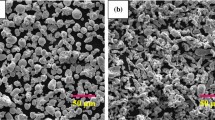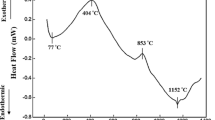Abstract
In the present work, hot press of Cu–15 wt% Al alloys was carried out in a vacuum environment at a sintering temperature of 500 °C for 30 min with varying pressure (100–500 MPa) to densify the alloys. Both the density and hardness of Cu alloys were significantly increased with increasing the hot press pressure. A maximum density of ~ 94.5% ρth (theoretical density) and microhardness of ~ 6.2 GPa was achieved for Cu–Al alloy after hot press at 500 °C with 500 MPa pressure application. The XRD, SEM-EDS analysis confirms the presence of solid solution α (Cu0.78Al0.22) and γ (Cu9Al4) inermetallic phases in the sintered samples. Maximum hardness of 7.88 GPa and elastic modulus of 177.35 GPa was measured for Cu–Al alloy using nano-indentation test. It must be noted that so far in the literature a maximum hardness of 4.9 GPa was reported for Cu-based materials. The alloy was also measured with a moderately high compressive yield strength (1019 MPa), compressive strength (1106 MPa), and a reasonable amount of strain (6.6%). The wear tests revealed that the Cu–15 Al alloy hot pressed at 500 MPa pressure can exhibit better wear properties. Low coefficient of friction (COF) of 0.15 and wear rate of 0.71 × 10−5 mm3/N-m was observed at a sliding speed of 0.25 m/s and high COF of 0.20 and wear rate of 4.33 × 10−5 mm3/N-m were noted with further increasing the sliding speed (1.25 m/s). Further microstructural characterization of worn surfaces reveals abrasion wear as the major dominant wear mechanism. The present work clearly demonstrates the use of a high amount of hot press pressure in achieving good sinter density for Cu–15 wt% Al alloys with superior hardness, better wear and compressive strength properties.












Similar content being viewed by others
References
Krebs S, Gartner F, Klassen T (2015) Cold spraying of Cu–Al–bronze for cavitation protection in marine environments. J Therm Spray Technol 24:126–135
Meyer L, Thedens M, Beyer M (2017) Incendivity of aluminium bronze in mechanical friction contacts. J Loss Prev Process Ind 49:947–952. https://doi.org/10.1016/j.jlp.2017.02.003
Gyimah GK, Huang P, Chen D (2014) Dry sliding wear studies of copper-based powder metallurgy brake materials. J Tribol 136:41601
Soliman HN, Habib N (2014) Effect of ageing treatment on hardness of Cu–12.5 wt% Al shape memory alloy. Indian J Phys 88:803–812
Prokoshkina D, Esin VA, Divinski SV (2017) Experimental evidence for anomalous grain boundary diffusion of Fe in Cu and Cu–Fe alloys. Acta Mater 133:240–246
Rabiee M, Mirzadeh H, Ataie A (2016) Unraveling the effects of process control agents on mechanical alloying of nanostructured Cu–Fe alloy. J Ultrafine Grained Nanostruct Mater 49:17–21
Heidarzadeh A, Saeid T (2016) Correlation between process parameters, grain size and hardness of friction-stir-welded Cu–Zn alloys. Rare Met 37:1–11
Nassef AE, Alateyah AI, El-Hadek MA, El-Garaihy WH (2017) Mechanical behavior and fracture surface characterization of liquid-phase sintered Cu–Sn powder alloys. Adv Mater Lett 8:717–722
Jawaharram GS, Dillon SJ, Averback RS (2017) Hardening mechanisms in irradiated Cu–W alloys. J Mater Res 32:3156–3164
Guo J, Rosalie J, Pippan R, Zhang Z (2017) On the phase evolution and dissolution process in Cu–Cr alloys deformed by high pressure torsion. Scr Mater 133:41–44
Korneva A, Straumal B, Kilmametov A et al (2016) Phase transformations in a CuCr alloy induced by high pressure torsion. Mater Charact 114:151–156
Gong YL, Ren SY, Zeng SD, Zhu XK (2016) Unusual hardening behaviour in heavily cryo-rolled Cu–Al–Zn alloys during annealing treatment. Mater Sci Eng A 659:165–171
Angelo PC, Subramanian R (2008) Powder metallurgy: science, technology and applications, Eastern ec. PHI Learning, New Delhi
Kajiwara S (1967) Transformation from a lattice of ‘ABCBCACAB’ stacking order to f.c.c lattice by deformation. J Phys Soc Jpn 23:656
Arnberg L, Westman S (1978) Crystal perfection in a noncentrosymmetric alloy. Refinement and test of twinning of the γ-Cu9Al4 structure. Acta Crystallogr Sect A Cryst Phys Diffr Theor Gen Crystallogr 34:399–404
Han P, Xiao F, Zou W, Liao B (2014) Influence of hot press temperature on the microstructure and mechanical properties of 75% Cu–25% Sn alloy. Mater Des 53:38–42
Rojas P, Vera R, Martínez C, Villarroel M (2016) Effect of the powder metallurgy manufacture process on the electrochemical behaviour of copper, nickel and copper–nickel alloys in hydrochloric acid. Int J Electrochem Sci 11:4701–4711
Martinez C, Briones F, Rojas P et al (2017) Microstructure and mechanical properties of copper, nickel and ternary alloys Cu–Ni–Zr obtained by mechanical alloying and hot press. MRS Adv 2:2831–2836
Ramkumar KR, Sivasankaran S, Alaboodi AS (2017) Effect of alumina content on microstructures, mechanical, wear and machining behavior of Cu–10Zn nanocomposite prepared by mechanical alloying and hot-pressing. J Alloy Compd 709:129–141
Youssef KM, Abaza MA, Scattergood RO, Koch CC (2018) High strength, ductility, and electrical conductivity of in situ consolidated nanocrystalline Cu–1%Nb. Mater Sci Eng A 711:350–355. https://doi.org/10.1016/j.msea.2017.11.060
Rabiee M, Mirzadeh H, Ataie A (2017) Processing of Cu–Fe and Cu–Fe–SiC nanocomposites by mechanical alloying. Adv Powder Technol 28:1882–1887. https://doi.org/10.1016/j.apt.2017.04.023
Kumar A, Pradhan SK, Jayasankar K et al (2017) Structural investigations of nanocrystalline Cu–Cr–Mo alloy prepared by high-energy ball milling. J Electron Mater 46:1339–1347. https://doi.org/10.1007/s11664-016-5125-x
Chakravarty S, Sikdar K, Singh SS et al (2017) Grain size stabilization and strengthening of cryomilled nanostructured Cu 12 at.% Al alloy. J Alloy Compd 716:197–203. https://doi.org/10.1016/j.jallcom.2017.05.093
Ren F, Arshad SN, Bellon P et al (2014) Sliding wear-induced chemical nanolayering in Cu–Ag, and its implications for high wear resistance. Acta Mater 72:148–158. https://doi.org/10.1016/j.actamat.2014.03.060
Sharma AS, Biswas K, Basu B, Chakravarty D (2011) Spark plasma sintering of nanocrystalline Cu and Cu–10 wt Pct Pb alloy. Metall Mater Trans A 42:2072–2084
Sharma AS, Mishra N, Biswas K, Basu B (2013) Densification kinetics, phase assemblage and hardness of spark plasma sintered Cu–10 wt% TiB 2 and Cu–10 wt% TiB 2–10 wt% Pb composites. J Mater Res 28:1517–1528
Eze AA, Jamiru T, Sadiku ER et al (2018) Effect of titanium addition on the microstructure, electrical conductivity and mechanical properties of copper by using SPS for the preparation of Cu–Ti alloys. J Alloy Compd 736:163–171
Huang K, Yang Y, Qin Y et al (2015) A new densification mechanism of copper powder sintered under an electrical field. Scr Mater 99:85–88
Patra S, Mondal K (2014) Densification behavior of mechanically milled Cu–8 at.% Cr alloy and its mechanical and electrical properties. Prog Nat Sci Mater Int 24:608–622
Kumar A, Jayasankar K, Debata M, Mandal A (2015) Mechanical alloying and properties of immiscible Cu–20 wt% Mo alloy. J Alloy Compd 647:1040–1047
Hao H, Ye S, Yu K et al (2016) The role of alloying elements on the sintering of Cu. J Alloy Compd 684:91–97
Nassef A, El-Hadek M (2016) Microstructure and mechanical behavior of hot pressed Cu–Sn powder alloys. Adv Mater Sci Eng 53:38–42
Biswas K, Sharma AS, Basu B (2013) On the densification mechanisms and properties of Cu–Pb and Cu–Pb–TiB 2 nanocomposites densified using spark plasma sintering. Scr Mater 69:122–126
Prasad BK (1997) Dry sliding wear response of some bearing alloys as influenced by the nature of microconstituents and sliding conditions. Metall Mater Trans A 28:809–815
Wu LL, Liu L, Qi MS et al (2012) Effects of cryogenic treatment on micro-mechanical properties of a Cu–Al alloy. Adv Mater Res Trans Tech Publ 562:196–199
Glas F (2005) Ziehen von edelstahlblechen mit werkzeugen aus aluminium-mehrstoffbronzen. Tribol und Schmier 52:55–63
Oliver WC, Pharr GM (1992) An improved technique for determining hardness and elastic modulus using load and displacement sensing indentation experiments. J Mater Res 7:1564–1583
Kan Q, Yan W, Kang G, Sun Q (2013) Oliver–Pharr indentation method in determining elastic moduli of shape memory alloys—a phase transformable material. J Mech Phys Sol 61:2015–2033
Ebenstein DM, Pruitt LA (2006) Nanoindentation of biological materials. Nano Today 1:26–33
Shokrieh MM, Hosseinkhani MR, Naimi-Jamal MR, Tourani H (2013) Nanoindentation and nanoscratch investigations on graphene-based nanocomposites. Polym Test 32:45–51. https://doi.org/10.1016/j.polymertesting.2012.09.001
Swadener JG, George EP, Pharr GM (2002) The correlation of the indentation size effect measured with indenters of various shapes. J Mech Phys Sol 50:681–694
Kucita P, Wang SC, Li WS, et al (2015) Microstructure characterization of hypereutectoid aluminium bronze composite coating. In: Journal of physics: conference series. IOP Publishing, p 12010
Al-Athel KS, Ibrahim M, Arif AFM, Akhtar SS (2017) Effect of composition and thickness on the hardness and scratch resistance of copper and copper alloy coatings. Arab J Sci Eng 42:1–10
Wu L, Liu L, Liu J, Zhang R (2012) Effects of high pressure heat treatment on microstructure and micro-mechanical properties of Cu77. 96Al22.04 alloy. Mater Trans 53:504–507
Beegan D, Chowdhury S, Laugier MT (2005) Work of indentation methods for determining copper film hardness. Surf Coat Technol 192:57–63
Briscoe BJ, Fiori L, Pelillo E (1998) Nano-indentation of polymeric surfaces. J Phys D Appl Phys 31:2395
Bao YW, Wang W, Zhou YC (2004) Investigation of the relationship between elastic modulus and hardness based on depth-sensing indentation measurements. Acta Mater 52:5397–5404. https://doi.org/10.1016/j.actamat.2004.08.002
Li WS, Wang ZP, Lu Y et al (2006) Mechanical and tribological properties of a novel aluminum bronze material for drawing dies. Wear 261:155–163. https://doi.org/10.1016/j.wear.2005.09.032
Nigam PK, Jain P (2013) Effect of heat treatment on tensile and compression strength of nickel aluminium bronze (Cu–10%Al–5%Ni–5%Fe). Arch Appl Sci Res 5:224–230
Moshkovich A, Perfilyev V, Lapsker I, Rapoport L (2014) Friction, wear and plastic deformation of Cu and α/β brass under lubrication conditions. Wear 320:34–40. https://doi.org/10.1016/j.wear.2014.08.016
Zhu W, Zhao C, Kwok CT et al (2018) Effects of nanocrystalline microstructure on the dry sliding wear behavior of a Cu–10 at.% Ag–10 at.% W ternary alloy against stainless steel. Wear 402–403:1–10
Ren F, Zhu W, Chu K, Zhao C (2016) Tribological and corrosion behaviors of bulk Cu–W nanocomposites fabricated by mechanical alloying and warm pressing. J Alloy Compd 676:164–172. https://doi.org/10.1016/j.jallcom.2016.03.141
Gao Y, Jie JC, Zhang PC et al (2015) Wear behavior of high strength and high conductivity Cu alloys under dry sliding. Trans Nonferrous Met Soc China 25:2293–2300. https://doi.org/10.1016/S1003-6326(15)63844-4
Maji P, Dube RK, Basu B (2009) Enhancement of wear resistance of copper with tungsten addition (≤ 20 wt%) by powder metallurgy route. J Tribol 131:041602. https://doi.org/10.1115/1.3204776
Chen X, Han Z, Lu K (2014) Wear mechanism transition dominated by subsurface recrystallization structure in Cu–Al alloys. Wear 320:41–50. https://doi.org/10.1016/j.wear.2014.08.010
Purcek G, Yanar H, Saray O et al (2014) Effect of precipitation on mechanical and wear properties of ultra fi ne-grained Cu–Cr–Zr alloy. Wear 311:149–158
Tu JP, Rong W, Guo SY, Yang YZ (2003) Dry sliding wear behavior of in situ Cu–TiB2nanocomposites against medium carbon steel. Wear 255:832–835. https://doi.org/10.1016/S0043-1648(03)00115-7
Sharma AS, Mishra N, Biswas K, Basu B (2013) Fretting wear study of Cu–10wt% TiB2 and Cu–10wt% TiB2–10wt% Pb composites. Wear 306:138–148
Pathak JP, Tiwari SN (1992) On the mechanical and wear properties of copper–lead bearing alloys. Wear 155:37–47
Acknowledgements
Ministry of Human Resource and Development, Government of India is gratefully acknowledged for the financial support to procure hot press equipment under plan grants. The authors gratefully thank the reviewers for useful comments.
Author information
Authors and Affiliations
Corresponding author
Rights and permissions
About this article
Cite this article
Shaik, M.A., Golla, B.R. Densification, microstructure and properties of mechanically alloyed and hot-pressed Cu–15 wt% Al alloy. J Mater Sci 53, 14694–14712 (2018). https://doi.org/10.1007/s10853-018-2638-0
Received:
Accepted:
Published:
Issue Date:
DOI: https://doi.org/10.1007/s10853-018-2638-0




